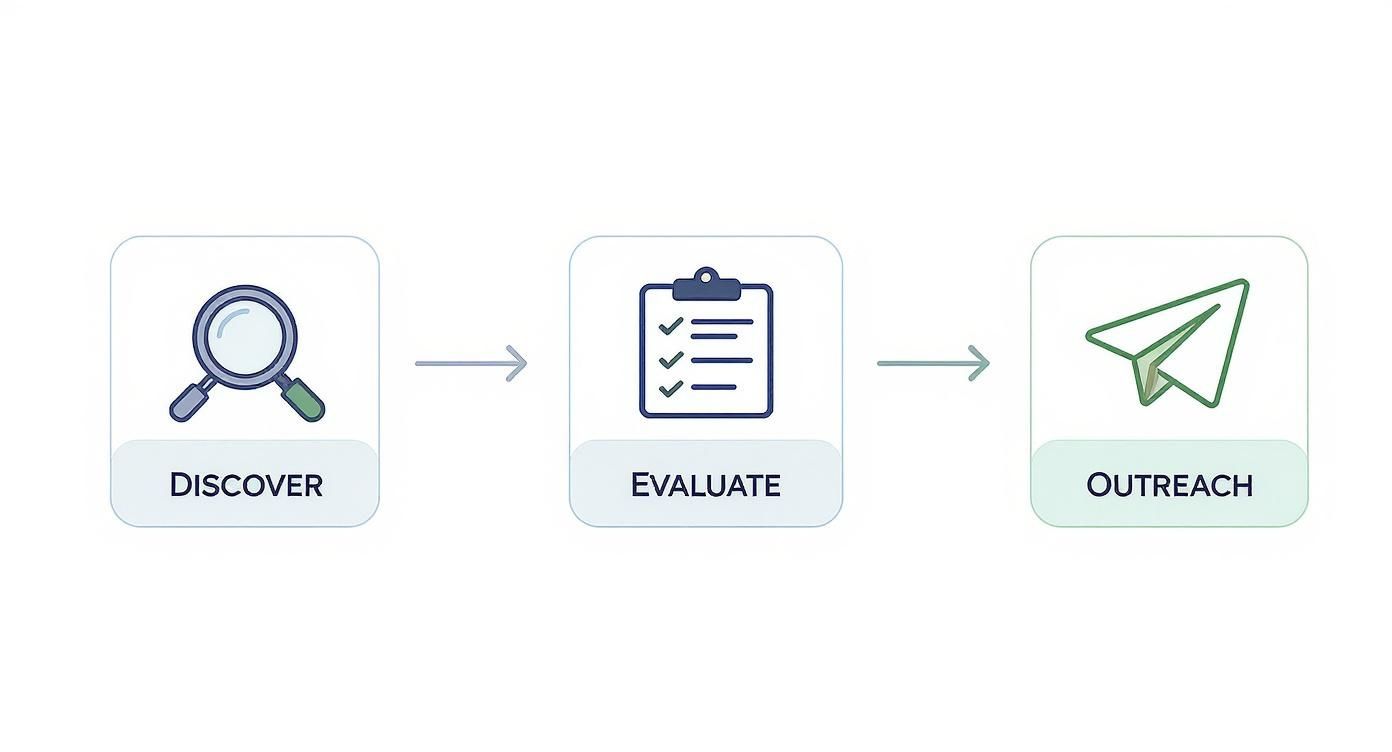
How to Find Backlinks on Google for Quick SEO Wins
Share
When you want to find backlinks on Google, you've got a few options. You could use advanced search operators like link:yourdomain.com for a quick look or intext:"yourdomain.com" -site:yourdomain.com to find mentions across the web. But honestly, the most accurate and direct way is to go straight to the source: the free "Links" report in Google Search Console. This report shows you your backlink profile exactly as Google sees it.
Why Finding Backlinks Is a Core SEO Skill

Learning how to find backlinks isn't just a box-ticking exercise. It's one of the most fundamental skills for anyone serious about building a successful SEO strategy. Instead of just guessing and blindly building links, analyzing backlink profiles—yours and your competitors'—gives you a real, data-driven roadmap.
Think of it as a form of market research. You get to see which content is resonating in your niche and earning those valuable "votes of confidence" from other websites.
Uncover Winning Strategies
When you dig into your competitors' backlinks, you're doing more than just collecting a list of URLs. You're essentially reverse-engineering their entire off-page SEO and digital PR playbook. You can see which sites they're guest posting on, what types of resource pages are linking to them, and which journalists are covering their stories.
This kind of intelligence is gold. It shifts your link-building from hopeful guesswork to a focused campaign built on tactics that are already proven to work in your industry.
Identify High-Value Opportunities
A solid backlink analysis will shine a spotlight on specific, actionable opportunities. It points you directly to high-authority domains that are already interested in your topic, making them perfect targets for your own outreach.
Getting an external hyperlink from a relevant, trusted site sends a powerful signal to search engines. This strategic approach means you can focus your energy on acquiring links that actually move the needle, helping you build authority and climb the rankings much more efficiently.
Find Your Own Backlinks with Google Search Console

Before you even think about paying for a third-party tool, your first port of call should always be Google Search Console (GSC). Why? Because this is Google's data, straight from the source. It gives you a direct look at the links their crawlers have found and are actually using to evaluate your site. It’s free, it’s accurate, and it’s the ultimate ground truth for your link profile.
Getting started is simple. Just head over to the “Links” report in the left-hand menu of your GSC property. The dashboard is split into two parts—External and Internal links. For our purposes here, we're diving deep into the External links section.
Interpreting Your Link Data
This is where the magic happens. The external links section gives you a few different ways to slice and dice the data, each offering a unique perspective on your site's authority.
Here’s what you’ll find:
- Top linking sites: This report lists the domains that link to you most frequently. It's a fantastic way to quickly identify your biggest fans. It can also help you spot red flags, like a suspicious number of links all coming from one low-quality directory.
- Top linked pages: Wondering which of your pages are pulling in the most links? This is where you find out. These pages are your proven "link assets"—the content that people in your industry naturally want to reference.
- Top linking text: This shows you the actual anchor text people are using when they link to you. A healthy, natural-looking profile will have a good mix of branded terms (like "Outrank"), keywords ("backlink analysis tools"), and generic phrases ("click here").
Backlinks aren't just a legacy ranking factor; they are as crucial as ever. A 2025 analysis of over 1,100 top-ranking websites found that a staggering 96.3% of them had backlinks from more than 1,000 different domains. This just reinforces the undeniable link between a diverse backlink profile and top search rankings. You can dig into the full study on the importance of backlinks for more details.
Get into the habit of checking these GSC reports regularly. It’s the best way to keep an eye on your link profile’s health, see if your content promotion is paying off, and understand how Google sees your site's authority in the real world.
Uncover Competitor Backlinks Using Google Search
While Google Search Console is your go-to for analyzing your own site's performance, you can get pretty creative and use Google itself to peek into your competitors' link-building playbooks.
No, this method won't give you a massive, exhaustive list of every single backlink they have—you'd need a paid tool for that. But it's an incredibly powerful and 100% free way to spot high-value link opportunities they've already secured. The secret lies in using advanced search operators.
Think of these operators as special commands that let you narrow your search with surgical precision. By stringing a few together, you can move past simple keyword searches and start doing some real SEO detective work, effectively reverse-engineering what's working for your competition.
Finding Unlinked Brand Mentions
One of the best low-hanging fruit opportunities is finding where a competitor is mentioned without a link. These are fantastic prospects for outreach because the site owner is already familiar with the brand. A simple search string can uncover these mentions while filtering out their own website.
Let's say your top competitor is "City Catering Supplies." You'd search for this:
intext:"City Catering Supplies" -site:citycateringsupplies.com
This command tells Google, "Show me every page that includes the exact phrase City Catering Supplies but isn't on their own domain." The results will often be blog posts, news articles, or forum threads where a link back to your own similar resource would be a perfect fit.
Pro Tip: Plug that exact search string into a Google Alert. You'll get an email every time your competitor lands a new mention, letting you swoop in on fresh opportunities without having to remember to search for them manually.
Discovering Guest Posts and Directory Links
Ever wonder where your rivals are guest posting? You can uncover their entire guest blogging strategy by combining their brand name with phrases commonly found in author bios or on "write for us" pages. This gives you a ready-made list of websites that are open to content from contributors in your niche.
Give these search queries a try:
"Competitor Name" + "guest post""Competitor Name" + "write for us""Competitor Name" + "a contributor for"
The same logic works beautifully for finding directory and resource page links. If your competitors are listed on industry-specific directories, you probably can be too. A quick search like "restaurant equipment" + inurl:directory can instantly surface pages that are actively linking out to businesses just like yours.
A Quick Guide To Search Operators
To help you get started, I've put together a quick reference table with some of the most effective search operators for backlink discovery.
Effective Google Search Operators for Backlink Discovery
| Search Operator Command | What It Finds | Example Usage |
|---|---|---|
site: |
Restricts results to a specific website. | site:forbes.com "your keyword" |
inurl: |
Finds pages with a specific word in the URL. | "gardening tips" inurl:blog |
intext: |
Finds pages with specific text in the body content. | intext:"City Catering Supplies" |
- (minus sign) |
Excludes a term or a site: operator from results. |
"marketing tips" -site:hubspot.com |
"" (quotation marks) |
Searches for an exact match phrase. | "best digital marketing tools" |
OR or ` |
` | Searches for A or B. Great for multiple keywords. |
Remember, every link a competitor earns is a clue. With the right search operators, you can follow that trail and build a powerful backlink profile of your own.
How to Evaluate Backlink Quality

Once you’ve uncovered some backlinks using Google, the real work begins: figuring out if they’re actually any good. It’s a common mistake to get excited about a high number of links, but a mountain of links from sketchy websites can hurt your site more than help it. The goal is to develop a sharp eye for quality, moving past raw numbers to truly understand each opportunity.
This focus on quality over quantity isn't just a best practice; it's how modern SEO works. In fact, 93.8% of marketers now agree that the quality of a backlink is far more important than the total count. Google has gotten incredibly good at rewarding sites that earn links from reputable, trustworthy sources.
Key Signals of a High-Quality Backlink
To train your gut instinct, you need to know what to look for. Think of it like a quick audit. A genuinely good backlink almost always comes from a website that has a clear purpose and provides real value to its own readers.
Here's a simple checklist I run through when sizing up a potential link:
- Topical Relevance: This is non-negotiable. Does the linking website talk about things related to your industry or niche? For a restaurant equipment supplier, a link from a popular food service blog is gold. A link from a pet grooming site? Not so much.
- Website Authority: Does the site itself look and feel legitimate? Is it well-maintained and professional? You can also lean on third-party metrics to get a sense of its strength. It’s worth understanding the difference between metrics like Ahrefs Domain Rating and Moz Domain Authority. And if you're looking to improve your own site's authority, our guide on how to build domain authority has some practical tips.
- Link Placement: Where the link appears on the page matters. A lot. A link woven naturally into the main body of an article is far more powerful than one stuffed into a footer, a crowded sidebar, or a long list of other links.
A single, editorially placed link from a highly relevant, authoritative website is worth more than a hundred low-quality links from spammy directories. Always prioritize relevance over volume.
By consistently applying these criteria, you'll get much better at spotting the opportunities that actually build long-term SEO value instead of just padding your backlink count.
Finding your competitors' backlinks is a great start, but it's only half the story. The real magic happens when you transform that raw data into a repeatable system for getting your own links. Think of that spreadsheet of competitor links not just as a list, but as a roadmap.
The first thing I always do is start sorting. You need to group those link prospects into logical buckets to see what's actually working in your niche.
Common categories I see all the time include:
- Guest Posts: Spotting all the sites that published content from your competitors.
- Resource Pages: Finding those curated "helpful links" pages where your own content would fit right in.
- Unlinked Mentions: These are gold. A site mentioned a competitor but didn't link—a perfect opening for you.
- Directory Listings: Industry-specific directories that are actually relevant and drive traffic.
Prioritize Your Outreach Plan
With your links neatly categorized, it's time to get strategic. Not all links are worth chasing. You have to prioritize based on relevance and authority. Landing a link from a major industry publication your competitor is on is a massive win compared to getting into a generic, low-value directory.
The game has changed a lot in recent years. A recent study showed that a whopping 89.6% of SEOs believe digital PR is the most effective way to earn high-quality links. It's all about building genuine brand awareness and relationships, not just asking for links. For more context, you can dig into the full report for other insights on effective link building tactics.
The end goal here is to build a predictable outreach machine. Once you understand the types of links helping your competitors rank, you can systematically find similar websites and pitch your own, better resources. This is how you turn simple analysis into a steady stream of powerful backlinks.
Once you’ve pinpointed these opportunities, the real work of outreach and acquisition begins. To get started, you can explore some proven strategies to build backlinks naturally that work well in today's environment.
For a much deeper dive into structuring your entire campaign from start to finish, check out our complete guide on how to build links effectively.
Frequently Asked Questions
Let's tackle a few common questions that pop up when you're getting started with finding backlinks on Google.
Can I Really Find All My Competitor's Backlinks Just Using Google?
The short answer is no, not really. While using Google search operators is a fantastic, free way to get a snapshot of a competitor's link-building activity, it won't give you the whole picture. It's more of a strategic peek than a complete audit.
For a comprehensive, exhaustive list of every single backlink, you'll need to turn to dedicated SEO tools like Ahrefs or Semrush. These platforms are built specifically to crawl the web and maintain massive link indexes. Think of Google as your starting point for quick analysis and spotting high-value opportunities without a subscription.
How Often Should I Be Checking for New Backlinks?
Good question. For your own site, a quick check of the 'Links' report in your Google Search Console once a month is a solid routine. It helps you keep an eye on your growth, see what content is attracting links, and catch any spammy or weird links before they become a problem.
When you're spying on competitors, checking for their new links every 2-4 weeks is a great rhythm. This keeps you in the loop on their latest strategies and helps you uncover fresh link opportunities as they happen.
A consistent process is key. It's all about discovery, analysis, and then outreach—a repeatable cycle.

This shows how successful link building isn't just a one-and-done task; it's a continuous loop of finding, vetting, and acquiring new links.
What's The Difference Between A Backlink And A Referring Domain?
This one trips people up all the time, but it's a crucial concept.
A referring domain is the website a link comes from. A backlink is the actual hyperlink itself.
Imagine you get two links from a single article on Forbes.com. In that case, you've just earned 2 backlinks from 1 referring domain (Forbes.com).
Search engines put a lot of weight on getting links from a diverse range of high-quality referring domains. It’s a powerful signal that your site is trusted and valued all across the web, not just by one source.
At Restaurant Equipment SEO, we translate this kind of backlink analysis into real-world growth. Our targeted link-building services are tailored for the food service industry, helping you build authority that drives qualified traffic. Ready to build a powerful link profile? Let's connect.